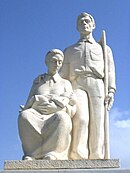
Back تاريخ بورتوريكو Arabic Història de Puerto Rico Catalan Geschichte Puerto Ricos German Historia de Puerto Rico Spanish Histoire de Porto Rico French Storia di Porto Rico Italian პუერტო-რიკოს ისტორია KA Geschiedenis van Puerto Rico Dutch História de Porto Rico Portuguese История Пуэрто-Рико Russian
| Part of a series on the |
| Culture of Puerto Rico |
|---|
 |
| Society |
| Topics |
| Symbols |
| History of Puerto Rico |
|---|
|
|

The history of Puerto Rico began with the settlement of the Ortoiroid people before 430 BC. At the time of Christopher Columbus's arrival in the New World in 1493, the dominant indigenous culture was that of the Taíno. The Taíno people's numbers went dangerously low during the latter half of the 16th century because of new infectious diseases, other exploitation by Spanish settlers, and warfare.[1]
Located in the northeastern Caribbean, Puerto Rico formed a key part of the Spanish Empire from the early years of the exploration, conquest and colonization of the New World. The island was a major military post during many wars between Spain and other European powers for control of the region in the 16th, 17th, and 18th centuries. In 1593, Portuguese soldiers, sent from Lisbon by order of Phillip II, composed the first garrison of the San Felipe del Morro fortress in San Juan. Some brought their wives, while others married Puerto Rican women, and today there are many Puerto Rican families with Portuguese last names. The smallest of the Greater Antilles, Puerto Rico was a stepping-stone in the passage from Europe to Cuba, Mexico, Central America, and the northern territories of South America. Throughout most of the 19th century until the conclusion of the Spanish–American War, Puerto Rico and Cuba were the last two Spanish colonies in the New World; they served as Spain's final outposts in a strategy to regain control of the American continents. Realizing that it was in danger of losing its two remaining Caribbean territories, the Spanish Crown revived the Royal Decree of Graces of 1815. The decree was printed in Spanish, English and French in order to attract Europeans, with the hope that the independence movements would lose their popularity and strength with the arrival of new settlers. Free land was offered to those who wanted to populate the islands on the condition that they swear their loyalty to the Spanish Crown and allegiance to the Roman Catholic Church.[2]
In 1898, during the Spanish–American War, Puerto Rico was invaded and subsequently became a possession of the United States. The first years of the 20th century were marked by the struggle to obtain greater democratic rights from the United States.
The Foraker Act of 1900 established a civil government, ending rule by American generals and the Department of War. A United States Supreme Court ruling Ortega v. Lara, 202 U.S. 339, 342 (1906),[a] involving the Foraker Act and referring to the island as "the acquired country", soon affirmed that the Constitution of the United States applied within its territory and that any domestic Puerto Rican laws which did not conflict with the United States Constitution remained in force.[3] The Jones Act of 1917, which made Puerto Ricans U.S. citizens, paved the way for the drafting of Puerto Rico's Constitution and its approval by Congress and Puerto Rican voters in 1952. However, the political status of Puerto Rico, a Commonwealth controlled by the United States, remains an anomaly.
- ^ "How Europeans Brought Sickness to the New World". www.sciencemag.org. 3 June 2015.
- ^ "Teoría, Crítica e Historia: La abolición de la esclavitud y el mundo hispano". Ensayistas.
- ^ Roselló, Pedro Luis Perea (April–June 1963). Santiago, Maria García; Vega, Pedro Malavey; González, José M. Novoa; Goyco, Edwin Toro (eds.). "Res communes omnium". Doctrina. Revista de Derecho Puertorriqueño. Printed in Spain: Imprenta vda. de Daniel Cochs—Cros. 23.—Barcelona (in Spanish). 2 (8). Ponce, Puerto Rico: Pontifical Catholic University of Puerto Rico School of Law: 7–24. ISSN 0034-7930.
Cite error: There are <ref group=lower-alpha> tags or {{efn}} templates on this page, but the references will not show without a {{reflist|group=lower-alpha}} template or {{notelist}} template (see the help page).